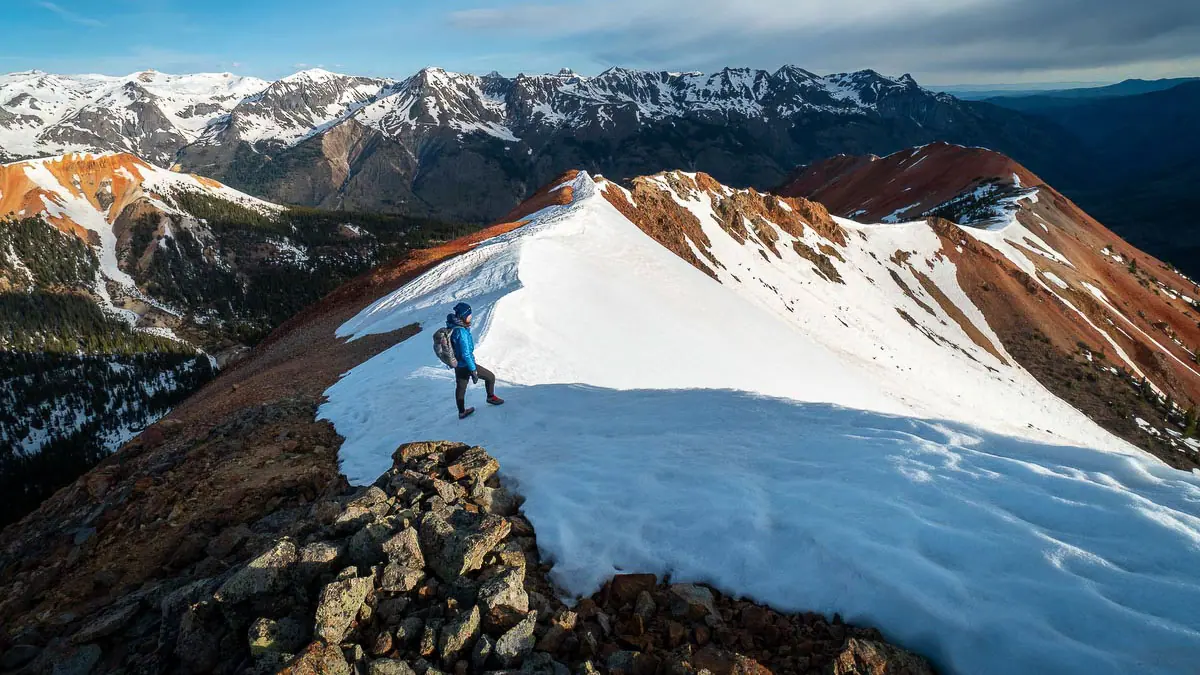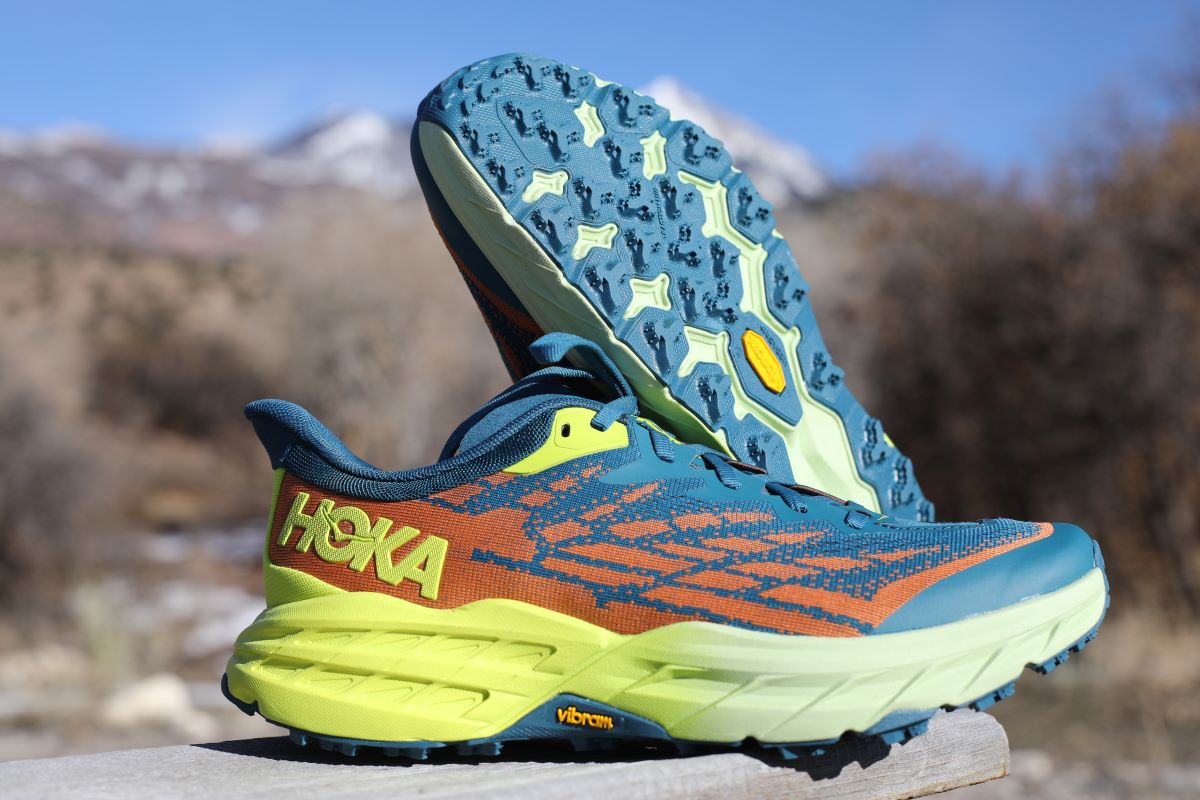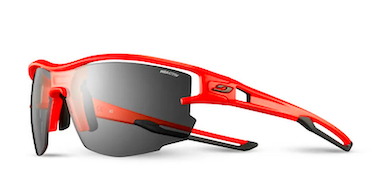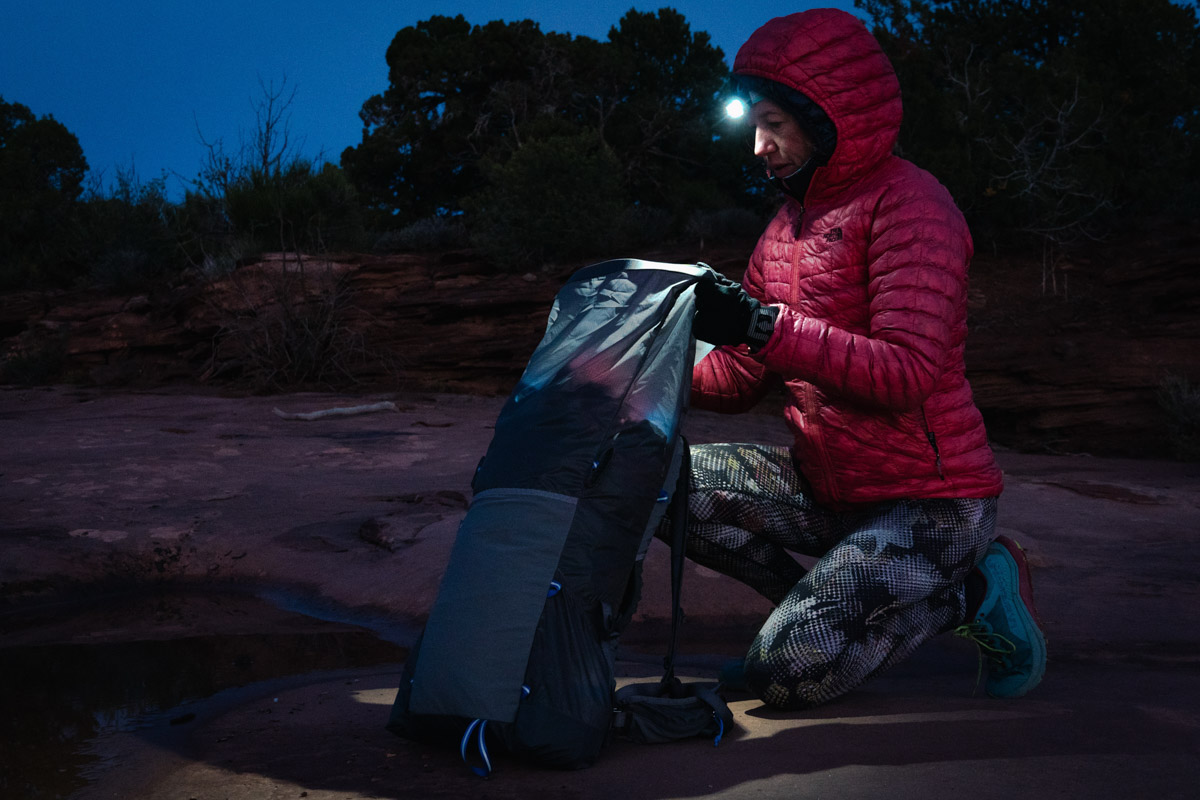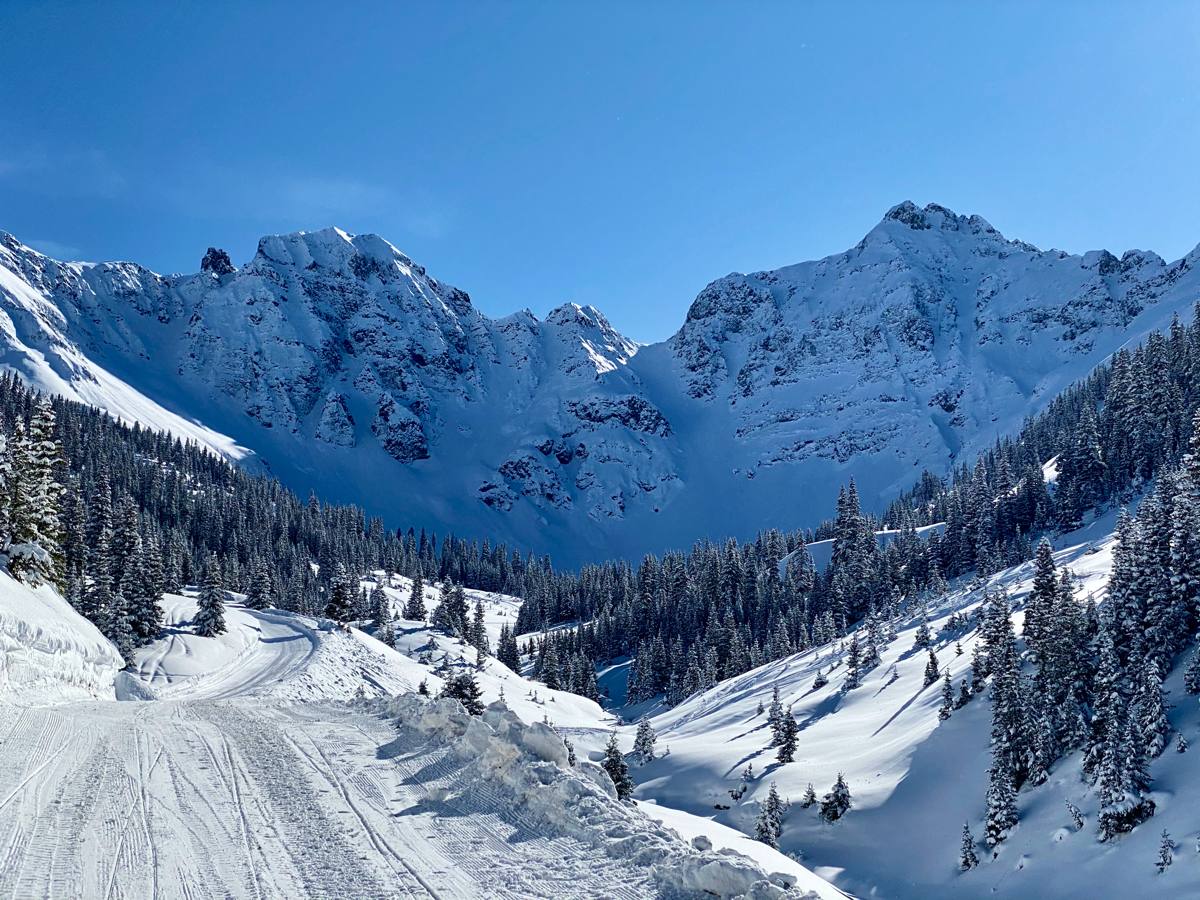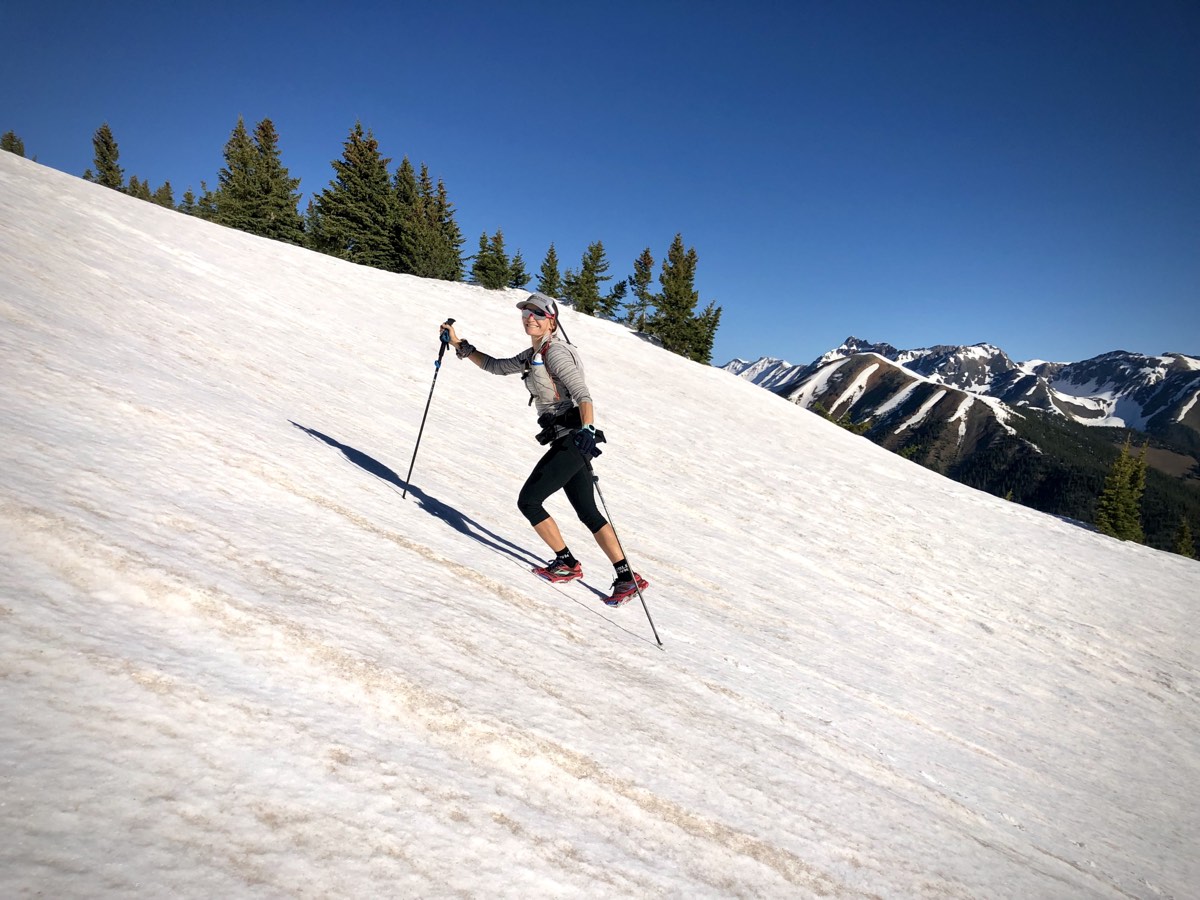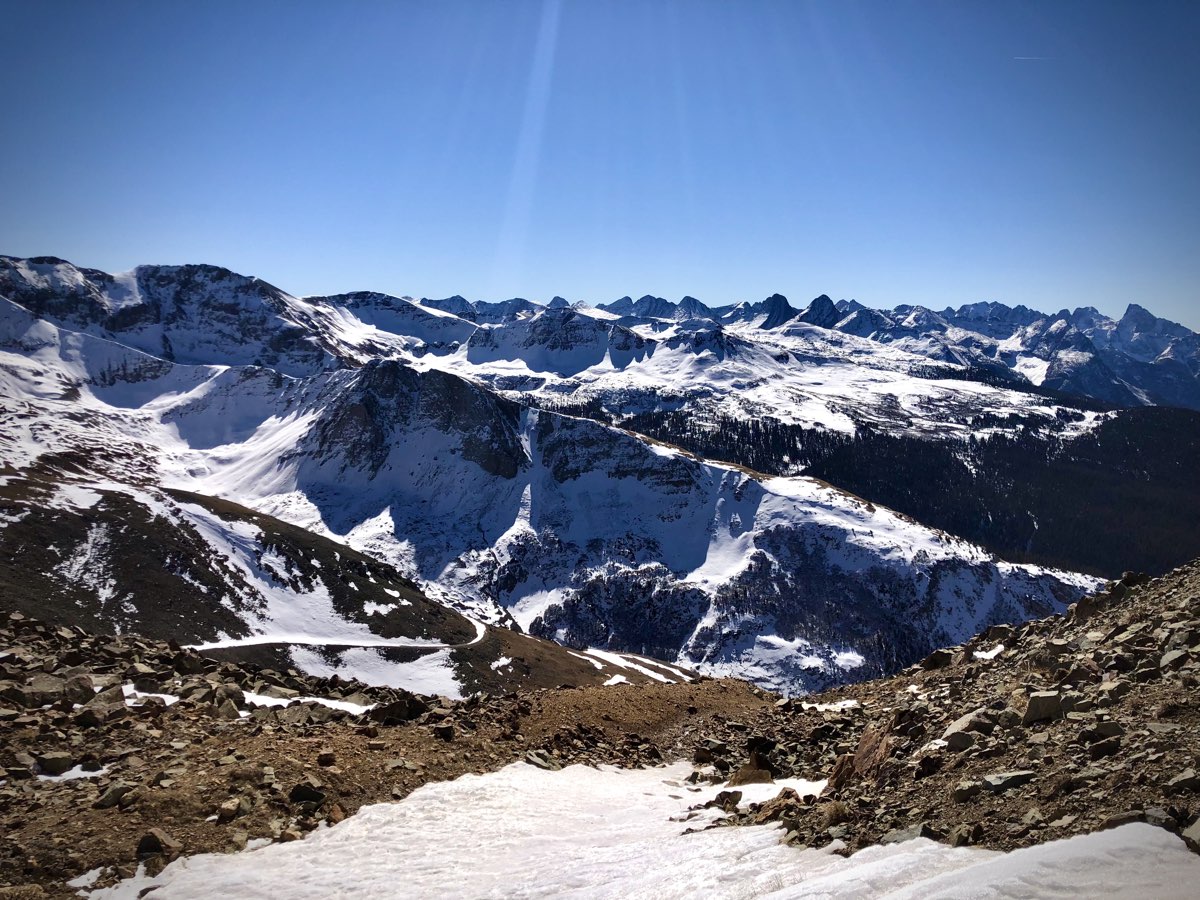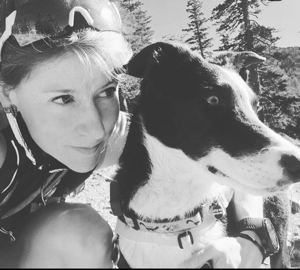When we think of running in the winter, we think of friends meeting on dark, cold mornings when our beds feel oh-so-warm. We think of the way the chilly air feels during those first 10 minutes and how softly yet suddenly the cold wanes, and we feel toasty.
We think of the way snow falls from a tree as we pass by and the sparkle of the snow as the sun rises. We think of empty sidewalks and muted roads. We think of the way the warmth of home hits our face, and the ice on our lashes melts when we walk in the door after a great winter run. Running in the wintertime is magical, and the iRunFar team wants you to experience that joy! With this guide, we share some of our favorite winter pieces to help you run safely and comfortably through the winter.
These pieces have been tested by our team over multiple years and seasons, on variable terrain, around the world, and in diverse winter conditions. We are excited to share these recommendations, selected for their strengths as well as their versatility.
You can also skip down to read our recommendations on how to choose the right cold weather running gear for you, our answers to your frequently asked questions about cold weather running gear, and how we put this guide together.
Best Cold Weather Running Gear
- Best Winter Running Shoes for All Conditions: Salomon Speedcross 6, Salomon Speedcross 6 Gore-Tex
- Best Winter Running Shoes for Packed Snow: Hoka Speedgoat 5, Hoka Speedgoat 4 GTX
- Best Winter Running Shoes for Ice: Salomon Spikecross 5 Gore-Tex
- Best Winter Traction Device for Off-Road Running: Black Diamond Distance Spike
- Best Winter Traction Device for Road Running in Mixed Conditions: Kahtoola EXOspikes
- Best Hydration Pack for Winter Running: Salomon Adv Skin 12
- Best Running Belt: Naked Running Band
- Best Windbreaker Jacket: Black Diamond Distance Wind Shell
- Best Rain Jacket: Outdoor Research Helium Rain Jacket
- Best Winter Running Jacket: Patagonia Nano-Air Hoody
- Best Hybrid Jacket for Winter Running: Patagonia Airshed Pro Pullover
- Best Base Layer Shirt for Winter Running: Smartwool Classic All-Season Merino Base Layer 1/4 Zip
- Best Midlayer Shirt for Winter Running: Patagonia Capilene Air Hoody
- Best Winter Running Tights: Patagonia Endless Run Tights
- Best Insulated Winter Running Tights: Gorewear R3 Thermo Tights
- Best Headband for Cold Weather Running: Buff Dryflx Headband
- Best Winter Running Beanie: Sauce Swift Toque
- Best Brimmed Hat for Winter Running: Buff Pack Merino Fleece Cap
- Best Gloves for Winter Running: Ultimate Direction Ultra Flip Glove
- Best Gloves for Very Cold Conditions: Trailheads Convertible Zip Mitts
- Best Sports Bra for Cold Weather: Smartwool Merino Sport Seamless Racerback Bra
- Best Wool Socks for Cold Weather: Smartwool Run Cold Weather Targeted Cushion Crew Socks
- Best Synthetic Socks for Cold Weather: Drymax Cold Weather Running Crew
- Best Headlamp for Winter Running: Petzl Iko Core
- Best Sunglasses for Winter Running: Julbo Aero

Winter running requires some extra gear but also provides its own set of rewards. Photo: iRunFar/Bryon Powell
Best Winter Running Shoes for All Conditions: Salomon Speedcross 6 ($140) and Speedcross 6 Gore-Tex ($160)
 The Salomon Speedcross 6 and the Salomon Speedcross 6 Gore-Tex are our top picks for general, all-around, variable-terrain winter running. For most winter conditions and sometimes during the shoulder seasons — hello, mud! — runners prioritize shoes with lugs and the traction they provide. The Salomon Speedcross 6 is the best trail running shoe we’ve found for these conditions, and the Gore-Tex version provides the additional benefit of being waterproof.
The Salomon Speedcross 6 and the Salomon Speedcross 6 Gore-Tex are our top picks for general, all-around, variable-terrain winter running. For most winter conditions and sometimes during the shoulder seasons — hello, mud! — runners prioritize shoes with lugs and the traction they provide. The Salomon Speedcross 6 is the best trail running shoe we’ve found for these conditions, and the Gore-Tex version provides the additional benefit of being waterproof.
These shoes not only have Salomon’s notoriously grippy outsole that helps with traction on nearly every surface but they are also built with five-millimeter multidirectional lugs to help dig into and generate grip in soft snow. They also adapt well to variable conditions where you may encounter a mix of soft snow, mud, or generally wet ground.
They aren’t the lightest shoes, though version 6 shaved off about an ounce in weight from the previous Speedcross 5. However, these shoes are very protective thanks to their tightly woven ripstop upper and hardy outsole, and we think that’s more important in a winter running shoe. Salomon shoes tend to be on the firm side with a nimble footprint. This is a definite strength when navigating sloshy, slippery terrain.
See why we also named the Salomon Speedcross 6 one of our favorite shoes in our Best Trail Running Shoes guide.
Shop the Women's Salomon Speedcross 6Shop the Men's Salomon Speedcross 6Shop the Women's Salomon Speedcross 6 Gore-TexShop the Men's Salomon Speedcross 6 Gore-Tex
Best Winter Running Shoes for Packed Snow: Hoka Speedgoat 5 ($155) and Hoka Speedgoat 4 GTX ($160)
The Hoka Speedgoat 5 made a big splash when it was introduced in 2022. Its predecessor, the Speedgoat 4, was already one of our trail favorites for its grippy outsole, stability, and ability to perform on aggressive terrain. The newest version kept what we loved while overhauling the upper and replacing it with a better-fitting and more durable knit mesh fabric, shaving weight from the midsole and making the outsole even grippier.
We’ve found that the Speedgoat 5 also holds its own in snowy conditions. We recommend this shoe and its Gore-Tex counterpart, the Hoka Speedgoat 4 GTX, on packed snow — think groomed trails where foot travel is permitted and urban singletrack that gets packed down by trail users. The rumor is that a Hoka Speedgoat 5 GTX is due out this winter, but we haven’t seen it yet.
Like the Salomon Speedcross 6 reviewed above, the Speedgoat 5 has five-millimeter lugs for traction but carries a slightly larger snowshoe-esque footprint and some increased cushion. As a result, its fit isn’t quite as precise, and that’s why we recommend it for more packed snow over slush or icy conditions.
Hoka describes the Speedgoat 5 as a shoe with neutral stability and a balanced cushion, but we have found the shoe to be very plush indeed. The standard version is also a pretty standard weight.
See why we also named it one of our favorite shoes in our Best Trail Running Shoes guide, and read our in-depth Hoka Speedgoat 5 review.
Shop the Women's Hoka Speedgoat 5Shop the Men's Hoka Speedgoat 5Shop the Women's Hoka Speedgoat 4 GTXShop the Men's Hoka Speedgoat 4 GTX
Best Winter Running Shoes for Ice: Salomon Spikecross 5 Gore-Tex ($185)
The Salomon Spikecross 5 Gore-Tex is a specialist when it comes to running in icy winter conditions. Not only do they feature the same five-millimeter lugs as the Speedcross above, but they also include small but very effective tungsten carbide spikes that help with grip on ice.
One of our team members has owned a single pair of Spikecross shoes for years. They’ve gotten her through multiple winters across the Western U.S., in Bellingham, Washington; Missoula, Montana; Flagstaff, Arizona; and Bend, Oregon. If you want confidence on the ice, we cannot recommend these enough. Taking a corner on ice can be unpredictable and risky, and after multiple winters running in these shoes, we’re impressed by the immediate confidence we have in keeping the rubber (and tungsten) side down — and keeping our bodies bruise-free.
What sets these apart when considering a shoe with built-in spikes versus a separate running traction device is the comfort on runs where we encounter a mix of both ice and clear roads. We found the Salomon Spikecross 5 Gore-Tex to be relatively comfortable on hard, non-ice-covered pavement. And, even after several winters of running on ice/pavement mix, the spikes have held up.
The lugs perform really well on trails where you anticipate ice but may also spend a lot of time trudging through snow. We love wearing these shoes on winter singletrack, where we anticipate areas of packed trail that have converted to ice. At an actual weight of 12.9 ounces, this is a heavy shoe, but that weight all goes to added traction and protection from snow, and for us, it’s well worth it.
Shop the Salomon Spikecross 5 Gore-TexBest Winter Traction Device for Off-Road Running: Black Diamond Distance Spike ($100)
Not long after this traction device hit the market, the Black Diamond Distance Spike became the go-to choice for the iRunFar team. The design is reminiscent of a mountaineering crampon, with a rubber wrap around the back and sides of the shoes, a fabric toe cap, and a pull tab at the heel to make it easy to put on.
Considering the amount of traction and toe coverage they provide, with 14 spikes at 8 millimeters long, the Distance Spike is extremely light. This design cuts the weight nearly in half compared to other traditional full-spike traction devices on the market today. The spikes are made of stainless steel and are heat-treated for strength, corrosion, and wear resistance.
To learn more about why the iRunFar team loves this traction device, read our in-depth Black Diamond Distance Spike review, as well as what we said about it in our Best Winter Running Traction Devices guide.
Shop the Black Diamond Distance Spike
A view of the Black Diamond Distance Spike with its innovative, weight-saving fabric toe cap. Photo: iRunFar/Bryon Powell
Best Winter Traction Device for Road Running in Mixed Conditions: Kahtoola EXOspikes ($63)
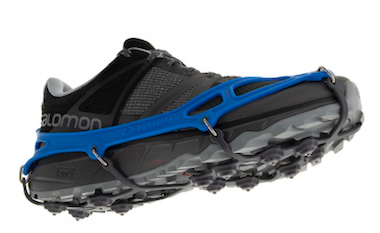 With tungsten carbide tips atop five-millimeter lugs, the Kahtoola EXOspikes have a profile similar to the Salomon Spikecross 5 Gore-Tex running shoes highlighted above. The key difference is that these traction devices can be placed on any shoe and removed when needed. The EXOspikes have a low profile with tiny metal nubs and a rubber wrap that easily goes over the sole of any shoe. If you’re running over slush, a bit of ice, or crusty forest roads, these are a great option.
With tungsten carbide tips atop five-millimeter lugs, the Kahtoola EXOspikes have a profile similar to the Salomon Spikecross 5 Gore-Tex running shoes highlighted above. The key difference is that these traction devices can be placed on any shoe and removed when needed. The EXOspikes have a low profile with tiny metal nubs and a rubber wrap that easily goes over the sole of any shoe. If you’re running over slush, a bit of ice, or crusty forest roads, these are a great option.
These traction devices are very light, despite their 12 spikes that are 10 millimeters long, and they afford stability on all kinds of road-running terrain. To learn more about these traction devices, check out iRunFar’s in-depth Kahtoola EXOspikes review and our Best Winter Running Traction Devices guide.
Shop the Kahtoola EXOSpikesBest Hydration Pack for Winter Running: Salomon Adv Skin 12 ($160)
The Salomon Adv Skin 12 is one of Salomon’s larger vests, with 12 liters of space to fit many layers and all the essential gear you need for long, cold outings. It even includes multiple carry options for collapsible trekking poles and is compatible with Salomon’s Quiver (sold separately). However, despite the capacity, it is a light and low-profile pack that fits the body well even when it’s nearly empty. This relatively sleek design allows you to wear the pack both over and under a shell jacket in the winter. The latter will help keep your water, food, and phone from freezing.
One complaint with this pack is that the two front pockets meant to hold soft flasks for hydration are tall and narrow and only really accommodate Salomon-specific HydraPak soft flasks. However, I think for winter outings, soft flasks can be preferable over a bladder, as I find that bladder hoses tend to freeze fairly quickly. Overall, this is a versatile pack that works well for mid-winter endurance races and adventures.
Be sure to check out our Best Hydration Packs for Running guide to see why we named this pack the best large-capacity hydration pack.
Shop the Salomon Adv Skin 12 Unisex Running VestShop the Salomon Adv Skin 12 Women's Running Vest
Best Running Belt: Naked Running Band ($55)
 When you need some additional space to carry smaller items, a waistbelt can be a nice way to add another mini-base layer of warmth and storage where your shirt and tights meet. And despite being only a running waistbelt, the Naked Running Band will accommodate different-sized hydration soft flasks from a variety of brands, as well as other gear, including a headlamp, sunglasses, phone, and nutrition. It also includes silicone grip loops to help carry larger items like poles or a jacket.
When you need some additional space to carry smaller items, a waistbelt can be a nice way to add another mini-base layer of warmth and storage where your shirt and tights meet. And despite being only a running waistbelt, the Naked Running Band will accommodate different-sized hydration soft flasks from a variety of brands, as well as other gear, including a headlamp, sunglasses, phone, and nutrition. It also includes silicone grip loops to help carry larger items like poles or a jacket.
Obviously, the more stuff you put in it, the bulkier it will be, but if you only need to carry a few things, this is a great option that fits well under a jacket — which is crucial for winter running as it helps keep food warm enough to not chip your teeth!
All of Naked’s products are billed as extremely light, and this running band is no exception. That’s pretty incredible when you consider it can hold up to two liters of storage.
Click over to our Best Running Belts guide to see why we named this one of the best running belts.
Shop the Naked Running BandBest Windbreaker Jacket: Black Diamond Distance Wind Shell ($140)
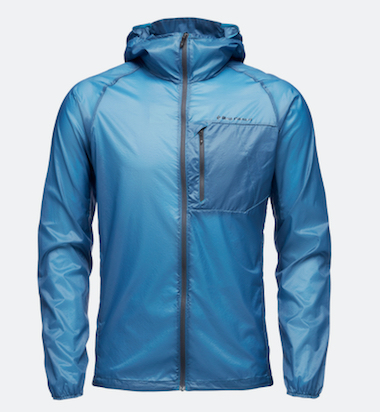 The Black Diamond Distance Wind Shell is very lightweight and optimal for milder winter days or for outings where you may need some extra wind protection. The material of the jacket is permeable, allowing it to breathe better than a more rain-oriented jacket. That said, it has a water-repellent finish and will provide some protection from the elements. The jacket itself is made of 100% nylon and 15-denier ripstop material, which helps it strike the perfect balance between sufficient wind protection and a featherlight item for your running quiver.
The Black Diamond Distance Wind Shell is very lightweight and optimal for milder winter days or for outings where you may need some extra wind protection. The material of the jacket is permeable, allowing it to breathe better than a more rain-oriented jacket. That said, it has a water-repellent finish and will provide some protection from the elements. The jacket itself is made of 100% nylon and 15-denier ripstop material, which helps it strike the perfect balance between sufficient wind protection and a featherlight item for your running quiver.
The Black Diamond Distance Wind Shell has a roomy fit, which is great for wearing over a pack or waistbelt to keep your food, water, and gear adequately thawed in winter weather.
This jacket also includes a hood large enough to accommodate a winter beanie, a headlamp, or a swishing ponytail; a chest pocket that also doubles as a stow pocket when the jacket needs to be packed away; and elastic cuffs at the wrists to help keep warmth in.
The iRunFar team named this one of the best wind jackets in our Best Running Wind Jackets guide.
Shop the Women's Black Diamond Distance Wind ShellShop the Men's Black Diamond Distance Wind Shell

The Black Diamond Distance Wind Shell is protective and fits well over a pack. Photo: iRunFar/Eszter Horanyi
Best Rain Jacket: Outdoor Research Helium Rain Jacket ($159)
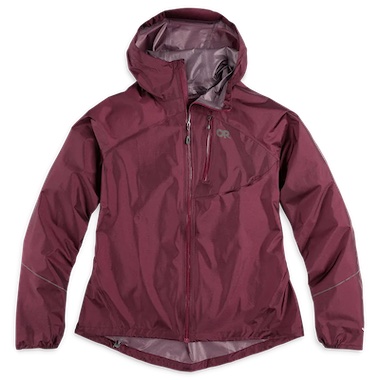 We love the Outdoor Research Helium Rain Jacket for its lightweight and small footprint when packed away, despite being a fully waterproof jacket. When not in use, it will take up minimal space in your running pack or tied around your waist. Other elements of the jacket include an adjustable hood, a drawcord hem, elastic cuffs, and a chest pocket that doubles as a stuff sack. And it’s available in sizes from extra small to 4X in women’s and small to 3X in men’s, which is more size-inclusive than we see in a lot of outdoor gear.
We love the Outdoor Research Helium Rain Jacket for its lightweight and small footprint when packed away, despite being a fully waterproof jacket. When not in use, it will take up minimal space in your running pack or tied around your waist. Other elements of the jacket include an adjustable hood, a drawcord hem, elastic cuffs, and a chest pocket that doubles as a stuff sack. And it’s available in sizes from extra small to 4X in women’s and small to 3X in men’s, which is more size-inclusive than we see in a lot of outdoor gear.
Made of 30-denier ripstop, this jacket is exceptionally lightweight while being extremely durable. However, since it’s waterproof, it’s also less breathable than a water-resistant jacket like the Black Diamond Distance Wind Shell above, so it can get a little warm if it’s just raining and not very cold.
iRunFar’s Alex Potter owns this jacket and runs in it often when the element to beat is either sleet or rain. She found this is a great lightweight option and attests that the hood is easily adjustable around the face and easily tucked behind the head if you don’t want it close by.
We chose the Outdoor Research Helium Rain Jacket as a top jacket in our Best Running Rain Jackets guide.
Shop the Women's Outdoor Research Helium Rain JacketShop the Men's Outdoor Research Helium Rain Jacket

The Outdoor Research Helium Rain Jacket being put to use during a chilly run in Moab, Utah. Photo: iRunFar/Eszter Horanyi
Best Winter Running Jacket: Patagonia Nano-Air Hoody ($299)
 When we asked our team for recommendations on jackets for this category, several people quickly replied with the Patagonia Nano-Air Hoody. Since it’s insulated, this was recommended for the very coldest days: 20 degrees Fahrenheit down to -20 degrees F. Two people noted that although it would be easy to get too warm while running in this jacket in any weather above these temperatures, the jacket has excellent wicking qualities that help prevent sweat from staying against your skin.
When we asked our team for recommendations on jackets for this category, several people quickly replied with the Patagonia Nano-Air Hoody. Since it’s insulated, this was recommended for the very coldest days: 20 degrees Fahrenheit down to -20 degrees F. Two people noted that although it would be easy to get too warm while running in this jacket in any weather above these temperatures, the jacket has excellent wicking qualities that help prevent sweat from staying against your skin.
This jacket features a hood with a halo drawstring and elasticity to fit snugly around your head and face. The cuffs are soft and stretchy, which helps contain warmth around your hands and wrists. When not used for the coldest of cold running adventures, our team said it’s thin enough to fit under a shell for additional warmth while winter biking, hiking, or casual around-town wear.
It easily squishes down into a backpack and can also fit into a larger hydration vest, like the Salomon Adv Skin 12 above. The durable water-repellent finish ensures you won’t get absolutely soaked if it starts to sprinkle.
iRunFar’s Alex Potter owns this jacket, which she purchased while working as a wildland firefighter. While she doesn’t run in it often because it truly is too warm for running in weather above 20F, she wears it almost every day out of the house for going about town, hiking, biking, and anything in between in temperatures from 30 to 50 degrees F.
Shop the Women's Patagonia Nano-Air HoodyShop the Men's Patagonia Nano-Air Hoody
Best Hybrid Jacket for Winter Running: Patagonia Airshed Pro Pullover ($139)
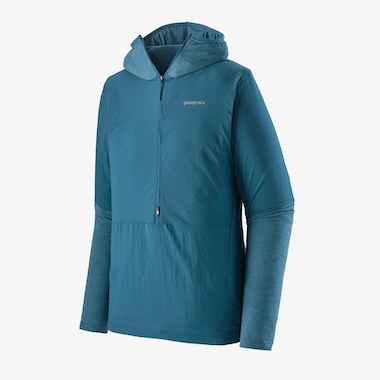 For year-round shoulder season conditions, the Patagonia Airshed Pro Pullover stands out as another hybrid layer that’s super versatile. It functions well in rain, wind, snow, a wide range of temperatures, or the classic all-seasons-in-one-day type of weather. This ultralight, thin “shacket” (shirt/jacket) has a combination of fabrics and features that are perfectly suited to the weather and temperature swings that runners frequently encounter.
For year-round shoulder season conditions, the Patagonia Airshed Pro Pullover stands out as another hybrid layer that’s super versatile. It functions well in rain, wind, snow, a wide range of temperatures, or the classic all-seasons-in-one-day type of weather. This ultralight, thin “shacket” (shirt/jacket) has a combination of fabrics and features that are perfectly suited to the weather and temperature swings that runners frequently encounter.
The jacket body consists of light, wind-blocking, and water-resistant polyester, while the sleeves and hood are made with thin, stretchy, and breathable nylon. The front zipper reaches halfway down and opens two ways — zipping up from the bottom or down from the top — letting you dump heat if you get too warm, though it also breathes well enough that overheating is rare. Like many of our favorite Patagonia layers, this one packs down small and stashes into its own pocket if you need to stow it away.
This jacket’s sleeves are nice and long for chilly winter mornings, and its hood stays on decently well, especially if you’re wearing a hat. Gusty winds will knock it down, but that’s to be expected. Otherwise, we love the balance of warmth, wind and rain protection, and breathability that this layer offers for any conditions that winter (or spring, summer, and fall) can throw our way.
Read more about this jacket in our in-depth Patagonia Airshed Pro Pullover review.
Shop the Women's Patagonia Airshed Pro PulloverShop the Men's Patagonia Airshed Pro Pullover
Best Base Layer Shirt for Winter Running: Smartwool Classic All-Season Merino Base Layer 1/4 Zip ($90)
 Smartwool has a variety of layers for pretty much any activity upon which you embark, and the Smartwool Classic All-Season Merino Base Layer 1/4 Zip is a versatile base layer that can be worn alone when it’s not super chilly or underneath a more substantial layer when the weather warrants. It’s a great option when you need that extra layer of comfort immediately out the door but know you’re likely to warm up. This base layer also works really well under a rain or wind jacket on late fall days when you have a protective layer on top to help combat rain or wind, but you don’t want to overheat.
Smartwool has a variety of layers for pretty much any activity upon which you embark, and the Smartwool Classic All-Season Merino Base Layer 1/4 Zip is a versatile base layer that can be worn alone when it’s not super chilly or underneath a more substantial layer when the weather warrants. It’s a great option when you need that extra layer of comfort immediately out the door but know you’re likely to warm up. This base layer also works really well under a rain or wind jacket on late fall days when you have a protective layer on top to help combat rain or wind, but you don’t want to overheat.
Wool base layers are ideal for a range of weather and temperatures because they pull moisture away from your body, retain warmth even when wet, are light on the skin, and dry quickly. The quarter-zip is the winning feature of this shirt because it’ll help you thermoregulate quickly — unzip, and you’ll quickly lose heat or zip it up all the way for those truly cold first miles of your run.
See iRunFar’s Best Wool Running Apparel guide to learn more about this shirt, which we named the best lightweight long-sleeve shirt.
Shop the Women's Smartwool Classic All-Season Merino Base Layer 1/4 ZipShop the Men's Smartwool Classic All-Season Merino Base Layer 1/4 Zip
Best Midlayer Shirt for Winter Running: Patagonia Capilene Air Hoody ($159)
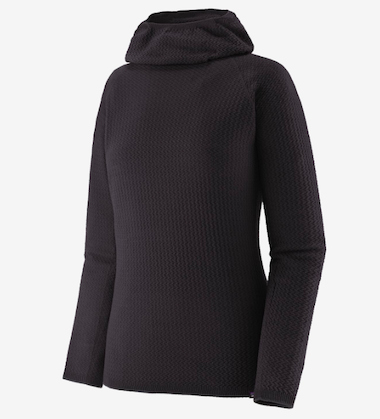 One member of the iRunFar team came to wear the Patagonia Capilene Air Hoody via an out-of-the-blue text recommendation from a friend they hadn’t heard from in over a year. She took their advice, and this shirt is now their go-to on medium-cold winter days.
One member of the iRunFar team came to wear the Patagonia Capilene Air Hoody via an out-of-the-blue text recommendation from a friend they hadn’t heard from in over a year. She took their advice, and this shirt is now their go-to on medium-cold winter days.
The lightweight and breathable sweater-like knit of this shirt may mislead you to think it is a light base layer. Not so. When paired with a vest, it keeps us surprisingly toasty on 20- to 30-degree F days. It’s very soft, with nice stretch and longer arms to provide extra coverage around your wrists and hands. Note its fabric is delicate and will snag or tear at the seams if you’re not careful.
The hood is minimal, with very little movement when not in use, and when pulled up, it fits snugly on your head and allows for good peripheral vision and the ability to hear your surroundings. The hood has Patagonia’s signature high neck that will come up over your mouth and nose for extra protection from the wind if needed but also tucks nicely under your chin and functions as a balaclava when you need a little less coverage.
Because of its open knit, this shirt could benefit from a windproof layer on blustery cold days, but it’s a gem that our team has used successfully on both mountain adventures and speedy road-tempo workouts in brisk conditions. An additional benefit is that this top looks nice enough to transition to the office if you’re running short on time or space in your run-commute pack. Since it’s 59% merino wool and made with an open knit, you can wear this thing for days, and it won’t get stinky — trust us, we do this on our fastpacking trips.
Shop the Women's Patagonia Capilene Air HoodyShop the Men's Patagonia Capilene Air Hoody
Best Winter Running Tights: Patagonia Endless Run Tights ($119)
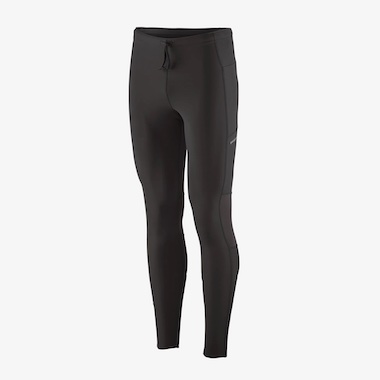 While they’re known for being breathable and moisture-wicking, we appreciate the Patagonia Endless Run Tights for their mid-rise fit, which moves well and doesn’t shift while you’re running.
While they’re known for being breathable and moisture-wicking, we appreciate the Patagonia Endless Run Tights for their mid-rise fit, which moves well and doesn’t shift while you’re running.
These tights are sufficient for a wide range of cool to cold days. They are made of material designed to keep you warm and dry, with mesh panels behind the knees for breathability. The tights have two side pockets for a phone, snacks, or other small essentials, as well as an elastic waistband with a drawcord. The women’s tights are sized to fit waist sizes ranging from 24.5 inches to 41.5 inches, and the men’s version will fit waist sizes ranging from 28 inches to 45 inches. Finally, these pants are Fair Trade Certified.
Shop the Women's Patagonia Endless Run TightsShop the Men's Patagonia Endless Run Tights
Best Insulated Winter Running Tights: Gorewear R3 Thermo Tights ($100)
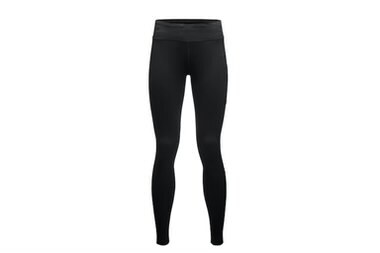 Don’t let the most challenging winter weather keep you from running! When it’s really cold and/or stormy, the iRunFar team turns to the Gorewear R3 Thermo Tights to get out the door for a run and stay protected and comfortable while we’re out there.
Don’t let the most challenging winter weather keep you from running! When it’s really cold and/or stormy, the iRunFar team turns to the Gorewear R3 Thermo Tights to get out the door for a run and stay protected and comfortable while we’re out there.
These tights are the warmest in the Gorewear running collection, with a brushed fleece lining for warmth and comfort. They are designed for cross-country skiing and running and therefore move well with your body and include panels of breathable poly-elastane to allow for natural venting.
These tights zip at the lower leg for easier donning and doffing. There is an easy-access side pocket on the thigh, as well as a small zippered rear pocket for keys and other small valuables. Their sizing is a bit more limited that the Patagonia tights above, however. The women’s sizes fit waists measuring from 23.5 inches to 32.25 inches, and the men’s tights fit waist sizes from 27.5 to 40.25 inches.
Shop the Women's Gorewear R3 Thermo Tights Shop the Men's Gorewear R3 Thermo Tights
Best Headband for Cold Weather Running: Buff Dryflx Headband ($17)
 Buff neck gaiters are so widely popular among runners and outdoor enthusiasts for their year-round versatility that neck gaiters are commonly referred to as “Buffs” in the way that tissues are often called “Kleenex.” While the standard Buff neck gaiter may not be your top choice for the coldest, windiest, and snowiest of days, the Buff Dryflx Headband is on the advanced end of the brand’s offerings, touting an ultralight, breathable, and quick-drying fabric.
Buff neck gaiters are so widely popular among runners and outdoor enthusiasts for their year-round versatility that neck gaiters are commonly referred to as “Buffs” in the way that tissues are often called “Kleenex.” While the standard Buff neck gaiter may not be your top choice for the coldest, windiest, and snowiest of days, the Buff Dryflx Headband is on the advanced end of the brand’s offerings, touting an ultralight, breathable, and quick-drying fabric.
The special feature of this Buff is that it has 360-degrees of reflectivity. Winter isn’t just cold, it’s dark, and any additional visibility increases your safety. Lighter than a feather, this thing will squish up and store anywhere, too.
Shop the Buff Dryflx HeadbandBest Winter Running Beanie: Sauce Swift Toque ($32)
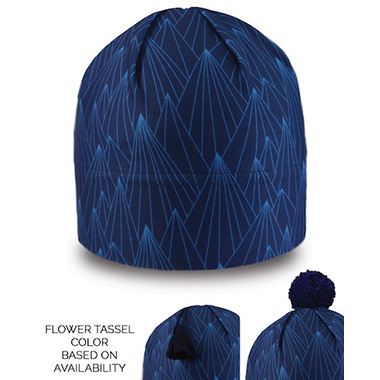 When the weather is such that a headband just won’t suffice, we reach for the Sauce Swift Toque, a fleece-lined beanie that’s designed for high-output activities in cold weather. The Bozeman, Montana-based brand was started by a former Canadian cross-country ski racer (hence the word toque and not beanie in the product’s name). Offering a range of headwear and fun patterns for folks who like to be active in cold weather, Sauce uses soft, performance fabrics that are comfy, breathable, and cozy.
When the weather is such that a headband just won’t suffice, we reach for the Sauce Swift Toque, a fleece-lined beanie that’s designed for high-output activities in cold weather. The Bozeman, Montana-based brand was started by a former Canadian cross-country ski racer (hence the word toque and not beanie in the product’s name). Offering a range of headwear and fun patterns for folks who like to be active in cold weather, Sauce uses soft, performance fabrics that are comfy, breathable, and cozy.
We like the versatility of this hat for running. It’s lightweight, stretchy, provides good coverage over the ears, and machine washable. Sauce offers lots of color and print options, from a muted solid black to vibrant patterns and mountain prints. Additionally, you have the option of adding a pom or tassel to the top at no additional cost — how fun is that?
Best Brimmed Hat for Winter Running: Buff Pack Merino Fleece Cap ($39)
 Fleece and merino wool pair together perfectly in the Buff Pack Merino Fleece Cap to help keep you warm on colder days. This cap includes an adjustable fit and a hidden ponytail hole to ensure a secure fit and maximum coverage in winter’s nastiest weather. An additional perk is the added brim — which is unique for a winter hat — to keep your eyes and skin shielded from the elements.
Fleece and merino wool pair together perfectly in the Buff Pack Merino Fleece Cap to help keep you warm on colder days. This cap includes an adjustable fit and a hidden ponytail hole to ensure a secure fit and maximum coverage in winter’s nastiest weather. An additional perk is the added brim — which is unique for a winter hat — to keep your eyes and skin shielded from the elements.
This is a really unique product and the first of its kind that we’ve used — the combination of brimmed hat, winter hat, and headband makes this the ideal topper for winter days that are also sunny and could have light snow as well — keeping your head warm and dry, but also keeping the light and snow showers out of your eyes.
To learn more, check out our Best Running Hats guide, where we named this the best hat for winter running.
Shop the Buff Pack Merino Wool Fleece CapBest Gloves for Winter Running: Ultimate Direction Ultra Flip Glove ($50)
 The glove-to-mitten combination is no longer a unique design, but the Ultimate Direction Ultra Flip Glove has been a favorite of iRunFar’s managing editor, Meghan Hicks, for several years. It was chosen in our Best Running Gloves guide and reviewed thoroughly in our Ultimate Direction Apparel Review.
The glove-to-mitten combination is no longer a unique design, but the Ultimate Direction Ultra Flip Glove has been a favorite of iRunFar’s managing editor, Meghan Hicks, for several years. It was chosen in our Best Running Gloves guide and reviewed thoroughly in our Ultimate Direction Apparel Review.
The convertible glove is a great design for variable temperatures — think a long run started in the morning where it warms up over time — for those who have circulation issues like Raynaud’s syndrome (when you don’t get enough circulation to your fingers), or for those who want a pair just for reassurance if the weather might turn while out on a daily adventure.
The inner glove is grid fleece, and the over-mitt is a silicone-coated Cordura ripstop. The mitten part of the glove folds up into the wrist section, which is a nice touch as this keeps the unused mitten portion from flopping about or getting in the way.
Shop the Ultimate Direction Ultra Flip GloveBest Gloves for Very Cold Conditions: Trailheads Convertible Zip Mitts ($52)
 We recently added the Trailheads Convertible Zip Mitts to our Best Running Gloves guide after discovering the benefits last winter of their Primaloft recycled polyester insulation, extended cuffs, and wrist straps that seal in warmth.
We recently added the Trailheads Convertible Zip Mitts to our Best Running Gloves guide after discovering the benefits last winter of their Primaloft recycled polyester insulation, extended cuffs, and wrist straps that seal in warmth.
These mitts are great for super-cold weather, which we consider to be temperatures that drop below 20 degrees Fahrenheit. So far, we’ve tested them in temperatures down to -15 degrees Fahrenheit, and they are still plenty warm for our team.
We love how these mitts make no compromises when it comes to keeping our digits warm in the depths of winter. At the same time, if we need to dig a car key out of our pocket, turn our headlamp off, or snap a photo of an epic sunrise, the mitts have a zipper that frees our hands for a brief moment. The only drawback of these supremely warm mitts is that they’re rather heavy and not easily packable, so they’re not the best choice if you anticipate needing to shed layers when the day warms.
That said, when it comes to running in frigid temperatures, it’s all about keeping your appendages warm and dry for safety purposes, and these mittens do just that.
Shop the Women's Trailheads Convertible Zip MittsShop the Men's Trailheads Convertible Zip Mitts
Best Sports Bra for Cold Weather: Smartwool Merino Sport Seamless Racerback Bra ($60)
Bras are a specialized category, and it’s challenging to appeal to all shapes and sizes, but when discussing comfort for winter running, we like the Smartwool Merino Sport Seamless Racerback Bra. It has a fairly simple, slim design — seamless to help reduce chafe, with wide straps that provide stability and support.
It has molded padding, which some people love and some hate. The good news is the pads are removable, so if you don’t like them, toss them. Most importantly, this bra has a merino wool liner for next-to-skin comfort that helps keep you dry and warm.
This bra is made of a mix of merino wool, nylon, and elastane, meaning it keeps you warm and dry while retaining a good bounce-back stretch. The seamless design isn’t the most stylish or engineered, but for winter activities, it’s the perfect item to keep your top half warm, dry, and comfortable.
See our Best Wool Running Apparel guide to see why we chose this as one of the best wool sports bras for running.
Shop the Smartwool Seamless Racerback BraBest Wool Socks for Cold Weather: Smartwool Run Cold Weather Targeted Cushion Crew Socks ($23)
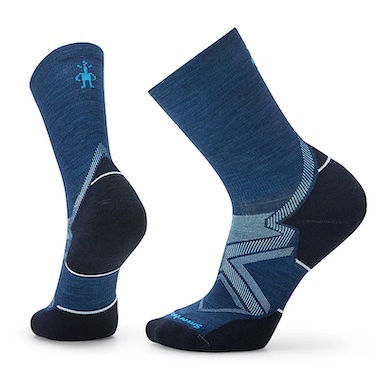 Designed just for running, the Smartwool Run Cold Weather Targeted Cushion Crew Socks are made with a merino blend — with nylon and elastane mixed in — with mesh zones to help keep your feet both warm and dry in colder weather.
Designed just for running, the Smartwool Run Cold Weather Targeted Cushion Crew Socks are made with a merino blend — with nylon and elastane mixed in — with mesh zones to help keep your feet both warm and dry in colder weather.
The mid-crew style is the perfect length for running in winter — it keeps your ankles covered and protected in a cold breeze, snow, and/or slush. Targeted cushions at the toe and heel help keep those areas blister-free, especially when the feet get wet. The toe is virtually seamless, so you don’t have to worry about blisters in that area, either.
Even though our team has given this sock the Goldilocks description of “not too thick, but not too thin,” they are a true winter sock. We found them to be a little on the thicker side.
We covered these socks and all of our favorites thoroughly in our Best Running Socks guide.
Shop the Women's Smartwool Run Cold Weather Targeted Cushion Crew SocksShop the Men's Smartwool Run Cold Weather Targeted Cushion Crew Socks
Best Synthetic Socks for Cold Weather: Drymax Cold Weather Running Crew ($19)
 Drymax tends to design slimmer products for almost all their running socks, so if you have narrower feet or like things to fit a bit tighter with a slightly higher ankle (almost to shin height), we like the Drymax Cold Weather Running Crew.
Drymax tends to design slimmer products for almost all their running socks, so if you have narrower feet or like things to fit a bit tighter with a slightly higher ankle (almost to shin height), we like the Drymax Cold Weather Running Crew.
They have a very good thermal conductivity rating, helping keep the skin warmer by drawing less heat away from the skin than socks made with other fibers. The material is a mix of Drymax-specific blend, polyester, and nylon.
Shop the Drymax Cold Weather Running CrewBest Headlamp for Winter Running: Petzl Iko Core ($90)
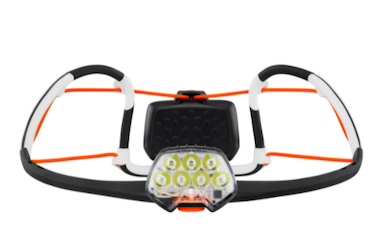 We particularly like the Petzl Iko Core headlamp for winter running because of the unique structure that allows it to easily fit over a hat or buff, or even a helmet. The headlamp is designed with a silicone band rather than the traditional stretchy headband common to most headlamps. Because it has a more solid skeleton, it also helps reduce pressure headaches and sore spots that can occur with other types of headlamps.
We particularly like the Petzl Iko Core headlamp for winter running because of the unique structure that allows it to easily fit over a hat or buff, or even a helmet. The headlamp is designed with a silicone band rather than the traditional stretchy headband common to most headlamps. Because it has a more solid skeleton, it also helps reduce pressure headaches and sore spots that can occur with other types of headlamps.
The Petzl Iko Core puts out a maximum of 500 lumens (which can reach 100 meters), has a minimalist design, and is super lightweight. It is rechargeable but is also compatible with three AAA batteries. If you’re in a pinch, it will run for 100 hours on the lowest six-lumen setting or 2.5 hours at the highest setting, 500 lumens.
You might want to read our Best Running Headlamps guide, where we rate this as the best headlamp for trail running.
Shop the Petzl Iko CoreBest Sunglasses for Winter Running: Julbo Aero with Reactiv 0-3 Lens ($230)
Sunglasses are an important piece of winter gear, as they not only help protect from the bright reflectivity of light glancing off snow but also shield your eyes from the cold winter wind and sleet. For winter running, we like the Julbo Aero with Reactiv 0-3 Lens.
Reactiv photochromic lenses get darker or lighter to match changing light conditions. At their darkest, the lens is dark enough for bright days on snow. Meanwhile, they’re absolutely clear during the dark of night. Julbo Aero sunglasses were designed with running and mountain biking in mind and allow for more breathability (and therefore minimal fogging) on slower uphill slogs.
While these look a little bit more technical than other running-specific sunglasses, we’ve found their sturdiness, durability, and eye protection to far outweigh any drawbacks in style.
In our Best Running Sunglasses guide, we named the Julbo Aero one of the top running sunglasses.
Shop the Julbo Aero with Reactiv 0-3 Lens
Buyer’s Guide: How To Choose the Right Cold Weather Running Gear for You
The Importance of Layering When Running in the Cold
When it comes to running in the cold, the most important part of staying safe and comfortable is properly managing your internal temperature under changing weather conditions and exertion levels. Staying warm while standing still in cold weather will require much more clothing than walking in it, and running will require even less than walking.
The body is only about 25% efficient when it comes to using energy for muscle contractions, meaning that for every unit of energy that is used to contract a muscle, three units of energy are released as heat. The faster we run, the more energy we use, and the more heat is created, making us warmer. Having layers to take off during a run can help maintain a steady body temperature as you warm up. Conversely, if you’ve done some hard efforts and are doing a cool-down jog, you’ll want to have extra layers to put on to compensate for your body generating less heat and cooling off.
Carrying a lightweight shell, like the Black Diamond Distance Wind Shell, can make it easy to add and remove layers as your run progresses.
Layers are also important to protect against changing weather conditions. Temperatures can drop drastically during the winter and become dangerous if you don’t have extra layers to protect against them. A shell layer, like the Patagonia Airshed Pro Pullover, is a great insurance policy against rapidly deteriorating weather conditions.
Safety Considerations When Choosing Cold Weather Running Gear
Cold-weather running can be dangerous without the right clothing and equipment. Hypothermia and frostbite are very real issues that need to be considered when gearing up to head outside in the cold. There are some basics to running in the cold that all trail runners should be aware of.
When skin is exposed to freezing temperatures for too long, frostbite can occur and cause permanent damage. The speed at which frostbite happens is dependent on the ambient temperature, wind chill, and the part of the body that is exposed to the air. Frostbite is most common on fingers, toes, the nose, ears, and other parts of the face. It occurs more quickly on areas of the body where there isn’t much blood flow to keep the skin warm. Frostbite can be identified by skin that has turned very cold and red before going numb and turning hard and pale. Minor cases of frostbite are often referred to as frostnip and can be treated by gently rewarming the skin. You can learn more about preventing and treating frostbite on the trail.
While frostbite can happen quickly, hypothermia generally has a slower onset and can be much more dangerous. Hypothermia occurs when the body temperature drops below 95 degrees Fahrenheit (35 degrees Celsius). Symptoms of mild hypothermia include shivering, dizziness, hunger, nausea, rapid breathing, increased heart rate, issues talking, and confusion. As it gets worse, it can result in increased shivering followed by a lack of shivering, lack of coordination, slurred speech, poor decision-making, drowsiness, weak pulse, and slow, shallow breathing. Ultimately, hypothermia can result in loss of consciousness and death.
Having the right clothing and gear to stay warm and dry in the cold is of critical importance. It’s also important to make good decisions when running in the cold. If you feel a part of your body going numb, you need to take action right away, whether it’s adding an extra layer, such as the Patagonia Capilene Air Hoody, to warm your core or just heading home. And while shivering is an amazing biological adaptation for staying warm, it’s a sign that your body’s temperature needs to be attended to.
Choosing Waterproof Versus Normal Running Shoes in Cold Weather
There are two main schools of thought when it comes to using waterproof shoes in the winter. When you’re running through puddles or mud, they can keep water out and keep your socks and feet dry, which will help keep them warmer. Waterproof shoes are also inherently warmer than non-waterproof ones because of the material of the uppers. But waterproof shoes are also less breathable than normal shoes, so when your feet sweat or water gets into them from around the ankles, there’s no place for that moisture to go, and this can lead to wet and clammy feet.
Feet get cold when the insulating layer around them, namely your socks, gets wet, and it doesn’t matter if they get wet from the rain or from sweat. One technique used by winter athletes to keep their feet warm is to wear a vapor barrier sock underneath their normal socks. Vapor barrier socks trap sweat next to the foot and keep it from getting the insulating sock wet. While this might sound counterintuitive, vapor barriers, which can be as simple as a plastic bag on your feet under your socks, are a great way to maximize the effectiveness of waterproof shoes, keeping your insulating sock dry both from the inside and the outside.
Whether you choose to go with waterproof or normal running shoes for your cold-weather outings, the Salomon Speedcross 6 and the Salomon Speedcross 6 Gore-Tex are great options for winter conditions.
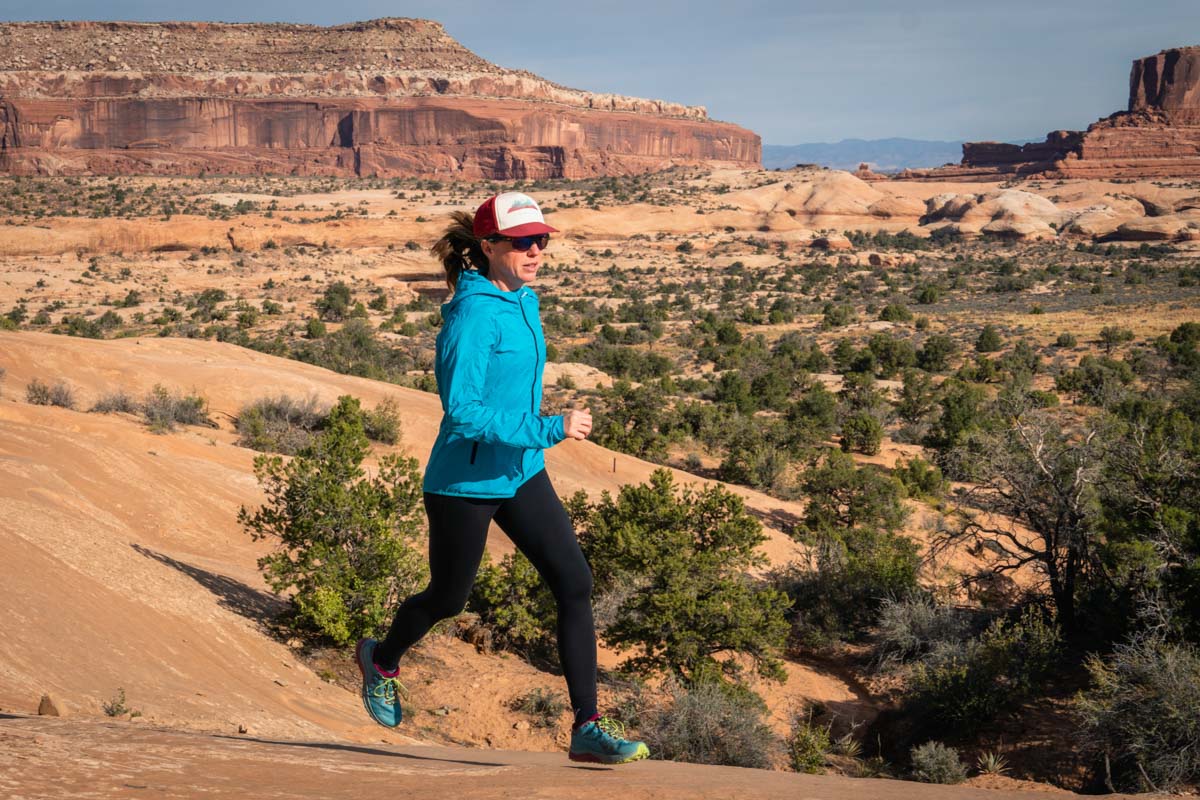
iRunFar’s Meghan Hicks tests jackets and tights on a chilly morning run in the desert. Photo: iRunFar/Eszter Horanyi
Choosing the Right Jacket for Cold Weather: Waterproof, Insulated, or Non-Insulated
The key to staying safe and comfortable during winter runs is to maintain a steady body temperature and to keep from getting wet, and different conditions call for different types of jackets. Each style of jacket has inherent benefits and drawbacks and can excel under specific circumstances. When it comes to a jacket that can do it all, we found that the Patagonia Airshed Pro Pullover was a great option for many weather conditions.
Fully waterproof jackets will keep you dry from any precipitation that is coming down and block the wind, but often aren’t very breathable and can leave you soaked from your own sweat, especially during high aerobic efforts. If you’re considering your options for a waterproof jacket for running in cold weather, take a look at our Best Running Rain Jackets guide. Our testers settled on the Outdoor Research Helium Rain Jacket as the best waterproof option for cold-weather running.
Insulated jackets can come in an array of materials, and some are made to be waterproof as well. A non-waterproof down jacket is a great option for staying warm under dry conditions as long as you’re careful not to sweat through it. Once down gets wet, from the inside of the jacket or the outside, it loses its insulating properties. Synthetic insulation will stay warm even when wet and can be a better option. Our team tested an array of jackets for this guide, and when it came to choosing our favorite insulated jacket, the Patagonia Nano-Air Hoody came out on top.
We also appreciated the light weight of the Black Diamond Distance Wind Shell and used it as a windbreaker shell for runs where we were certain there wouldn’t be any precipitation.
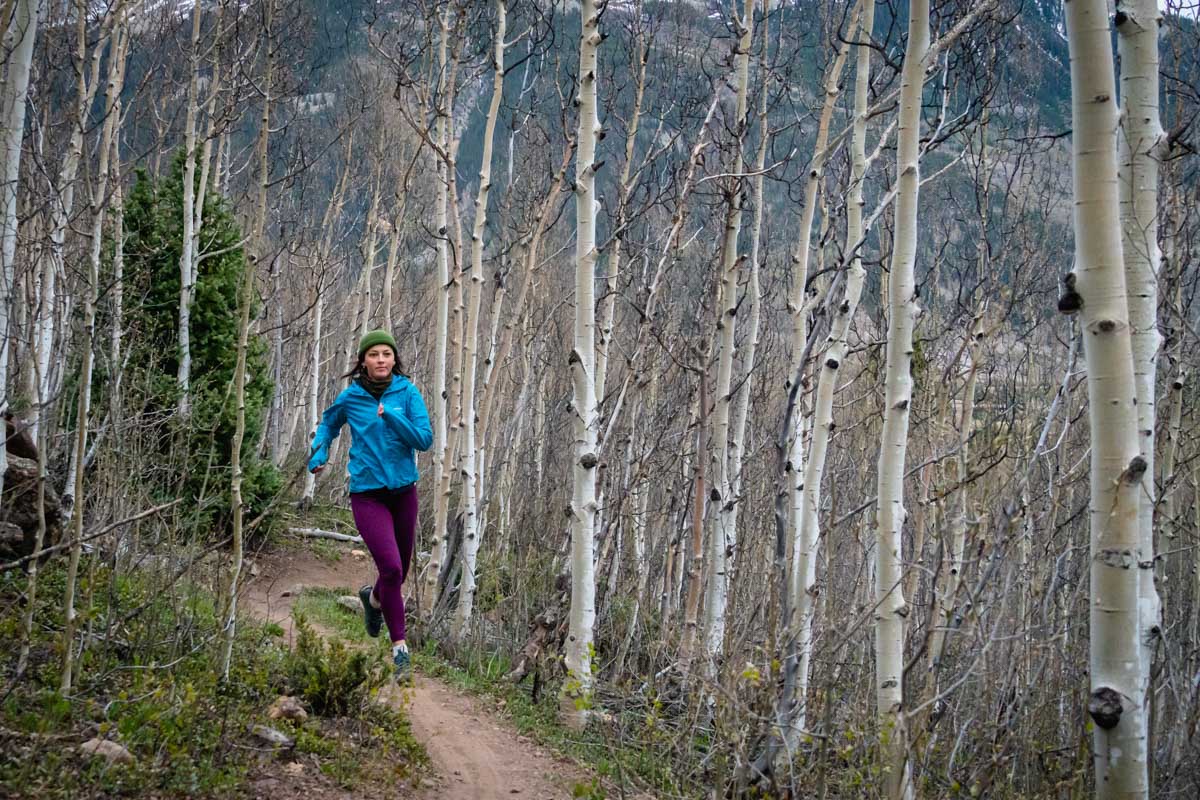
When the trees lose their leaves in the fall, it’s time to add warm layers. Photo: iRunFar/Eszter Horanyi
Choosing Gear for Staying Dry While Running
Sweat and condensation are enemy number one when running in the cold and can take you from comfortable to hypothermic in a short period of time. There are many ways to maintain an even body temperature, including moderating your effort, adding or removing layers, or increasing ventilation. One thing is for sure, if you find yourself starting to sweat, you need to do something about it quickly. The same goes for getting cold. A little prevention can go a long way toward avoiding a dangerous situation.
Clothing that breathes well is important to staying dry. Synthetic materials and wool are great options for clothing materials that will wick moisture off of your skin and help it evaporate into the air. Wearing layers also makes it easy to adjust the amount of insulation you have on different parts of your body. Removing a hat or unzipping a jacket can let your body offload heat and keep it from sweating excessively. Many tops designed for winter use have both front zips and underarm zips to help a warm body vent.
Wearing a pack when running in the cold can keep sweat from evaporating from your back. Using a waistbelt like the Naked Running Band to carry keys and snacks can keep the clothing around your core wicking moisture efficiently and prevent a sweaty back.
Why Wool Is a Good Choice for Cold Weather Running Gear
Merino wool is a go-to material for many people who exercise in cold weather. Grown on merino sheep, this lightweight fiber is both insulating and breathable. Its properties allow it to trap air in order to provide insulation while transporting moisture from your skin before it has the chance to turn into droplets and make everything damp. Modern merino clothing is soft and comfortable throughout a range of temperatures and has the added bonus of not getting stinky after a single run. It comes in an array of weights and can be used as a base layer, midlayer, or both. We also loved the Buff Pack Merino Fleece Cap for our cold weather runs. Most modern wool clothing is actually a blend of merino wool with something like Tencel, nylon, or polyester in order to make it a more durable material and decrease its drying time.
You can read more about the gear that made our Best of Wool Running Apparel guide to learn more about the unique properties of wool.
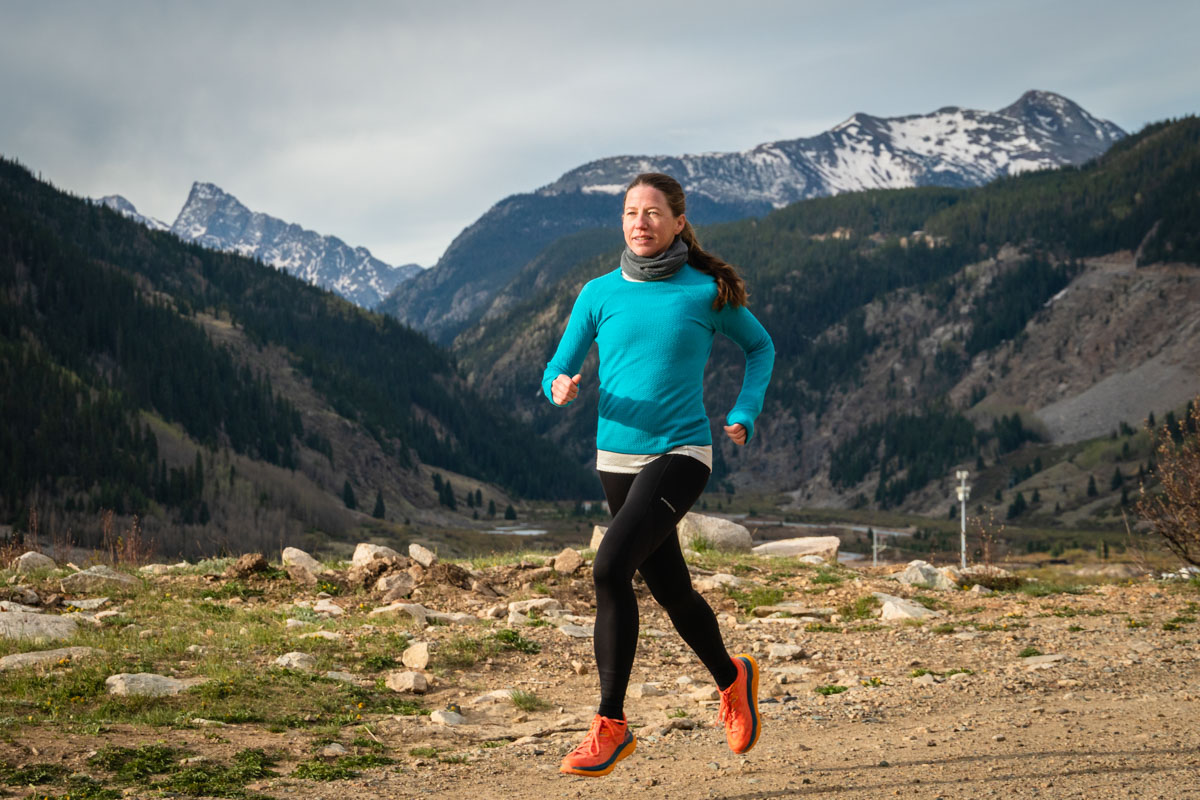
Meghan Hicks of iRunFar testing midlayers during a chilly morning run in Silverton, Colorado. Photo: iRunFar/Eszter Horanyi
Choosing the Right Cold Weather Running Gloves
A lot of runners struggle with keeping their hands warm. Fingers already receive relatively light blood circulation when compared to other parts of your body, and when your body starts to get cold and needs to conserve heat, it’ll reduce blood flow to your extremities, including your fingers. This helps the body keep warm blood in the core and protect vital organs. For people suffering from Raynaud’s syndrome, their bodies overreact to cold and shut off most blood circulation to the fingers, turning them numb and white. For those suffering from Raynaud’s, cold hands can occur at a relatively warm temperature. You can read more about managing Raynaud’s sndrome and keeping extremities warm.
Having the right gloves can make a big difference in comfort, whether you suffer from Raynaud’s or not.
Normal five-fingered gloves come in a variety of weights and can provide anything from a little extra warmth to ward off the chill to protection against truly arctic conditions. When temperatures start to get extremely cold, mittens will keep your fingers much warmer than any pair of regular gloves. As with all pieces of gear for cold weather running, you want to make sure that you’re not sweating too much and getting the insulation wet from the inside.
Convertible gloves, like the Ultimate Direction Ultra Flip Glove, are a great option for managing the warmth of your hands. They consist of a lighter pair of five-fingered gloves with a mitten cover, which can provide a lot of extra protection when it starts to get cold. When temperatures rise again, or you find your hands getting sweaty, you can pull the mitten shell off to provide more ventilation and temperature control. You can check out some of our favorite gloves for running in our Best Running Gloves guide.
Choosing the Right Hat for Cold Weather Running
While the idea that we lose half of our body heat through our head has been shown to be a myth, a covered head can make a big difference when it comes to staying warm. Hats are also a great option for regulating body temperature since they are so easy to take off if you start to get hot, and they stash easily in a pack or in a fist until they are needed again. Our team loved the fleece-lined Sauce Swift Toque for running in cold weather. Not only did it provide plenty of warmth, but it was easy to store.
Winter hats come in many styles, but the key is to choose one that has some insulation for your noggin and blocks the wind. Many winter hats come with a brim, like the Buff Pack Merino Fleece Cap, and extra material to cover your ears since they are often one of the first parts of a body to get cold.
Why Trust Us
We at iRunFar don’t shy away from running and fastpacking in cold weather. Many members of our testing team are based in locations where winter temperatures can get frigidly cold in the winter, including Alaska, Idaho, Colorado, Minnesota, and Montana. We’ve spent decades experimenting with different cold-weather running setups and developed systems that keep us warm and dry in the worst of conditions. Our testing team goes out in an array of temperatures, ranging from just a little bit chilly to downright arctic. We’ve tested gear options extensively so that we can provide the best recommendations for running in a variety of cold weather conditions.
Please note that in the running world, product models are routinely discontinued, while new ones frequently come to market. At the same time, we here at iRunFar often keep using our top picks in our daily running … they’re our top picks, after all! Sometimes that continued use results in uncovering product failures. With all this — product discontinuations, product introductions, and product failures — in mind, we routinely update our buyer’s guides based on past and ongoing testing as well as research by our authors and editorial team. While these updates can appear to be us pushing the newest product, it’s anything but that. When we update any buyer’s guide, most of the products are likely to remain the same. That matches our goal: to get you in the best gear that you’ll be using for a long time.
Frequently Asked Questions About Cold Weather Running Gear and Running in Cold Weather
When is it too cold to run outside? Is it safe to run in cold weather?
While as runners, we like to think of ourselves as tough and ready to run in any conditions, there are temperatures where it’s simply a better idea to either move a workout inside or just sit in front of a fire with a cup of hot cocoa instead.
Running when it’s extremely cold out has the potential to damage your lungs, especially if you’re breathing hard. If it’s below 17 degrees Fahrenheit, you’ll want to avoid breathing hard or gasping during your workout. It’s even more important to listen to your body during cold-weather runs, and if you feel your lungs getting irritated by the cold, you’ll want to stop and get warm as soon as possible.
Cold temperatures can also lead to frostbite, especially on bits of skin that are exposed to the elements. The speed at which frostbite occurs is dependent on the ambient temperature and windchill. Keeping facial skin covered with some sort of warm material can help reduce the chance of frostnip or frostbite and allow you to stay out in colder temperatures.
You’ll also need to pay extra attention to keeping your joints warm when running in extreme cold. Having a good pair of insulated tights like the Gorewear R3 Thermo Tights can protect your knees from the elements and help keep your ankles and feet warmer during the coldest of cold runs.
To learn more about staying safe while running in the cold, read our science article on cold weather running.
What’s the best jacket for running in cold weather?
Choosing the right jacket for running is highly dependent on the conditions. You’ll want a jacket that is able to block the wind and provide insulation to trap heat next to your body to help you maintain a steady core temperature. You also want a jacket to be as breathable as possible to keep your base and midlayers from getting soaked in sweat. If you think that sounds like a stretch for any single jacket’s functionality, you’re not wrong, and most runners will end up with an array of jackets to suit different conditions. A jacket that has a full zipper and vent and pit zips can be workable in a variety of temperatures by allowing you to increase airflow on your body and regulate your core temperature during a run. Our team found the Patagonia Nano-Air Hoody to be a highly versatile jacket that we could use in a variety of cold-weather conditions.
Do I need a waterproof or Gore-Tex running jacket to run in the winter?
If you live in a place where most of the winter precipitation comes down as rain, a good waterproof or Gore-Tex jacket is important. We chose the Outdoor Research Helium Rain Jacket as our favorite waterproof jacket and were able to adjust our layers underneath it to keep our core at the right temperature. If you find yourself running in snow frequently, you’ll have to worry less about incoming precipitation getting you wet from the outside since if it’s cold enough, the falling snow won’t melt on you. In snowy climates, you might be better off with breathable layers than a full waterproof jacket. Gore-Tex jackets are a great waterproof and breathable option, but they cost significantly more than a less breathable waterproof option.
What are the best shoes for running on snow and ice?
Finding the right shoes for running on snow and ice can keep your feet warm and help save you from a nasty spill on a slick surface. To help you find purchase on snow, you’ll want a shoe with good lugs that can grip into the soft surface. Our testers found the Hoka Speedgoat 5 to handle better on packed snow than the rest of the shoes we tested. Sticky rubber can also improve traction on slippery surfaces. The carbide tips on the bottom of the Salomon Spikecross 5 Gore-Tex provide an amazing amount of traction on hardpacked snow and ice for being relatively small and unobtrusive. When it comes to pure ice, especially when it’s off-camber, there’s not much that most shoes can do, and you’ll want to start considering using traction devices.
Having a set of traction devices can allow you to use whatever shoes you want on your winter run, but with extra grip. You can read a full review of iRunFar’s favorite traction devices to help you choose the right ones for your running conditions.
One thing to consider when running in the cold is the type of socks you’re going to wear and if it’s worth getting a shoe that’s a half-size or a full-size bigger. Generally, cold feet aren’t a direct result of cold temperatures but of poor circulation. Trying to shove your foot with a thick sock into the same shoe you use for summer running can reduce circulation to your feet and make them colder than if you just went with regular socks.
Do I need to wear waterproof or Gore-Tex running shoes in the winter?
Waterproof and Gore-Tex running shoes are great at keeping moisture out as long as you’re not going through water or snow that is higher than the top of the shoe. They are also warmer than normal running shoes. The downside of fully waterproof shoes is that they don’t allow sweat to escape from the inside, which can result in socks that are just as wet as if you were wearing a normal shoe and running through rain or snow. Gore-Tex, which is both waterproof and highly breathable, alleviates some of the issues with sweaty socks by allowing moisture to escape. Our testers frequently ran on snow and ice in the winter and loved the Salomon Spikecross 5 Gore-Tex. Not only does this shoe have a warm Gore-Tex upper, but it also has built-in carbide spikes that provide extra traction on slippery surfaces.
Should I wear traction devices to run in the winter?
If you’re consistently running on snow and ice, you’ll want to have a pair of traction devices handy both for safety and running comfort. Traction devices can be useful both on softer-packed snow and on ice. Even on softer surfaces, they can make running easier by taking the fear of slipping out of the equation. They’re functional on decently steep grades, but once you start getting on steep, hard snow, you’ll want to start considering upgrading to proper mountaineering crampons. Our testers chose the Black Diamond Distance Spike as the best off-road traction device due to its grip and ease of use. They can be a bit much for mixed-surface running, and our testers turned to the Kahtoola EXOspikes for runs that went from ice to snow to dirt to pavement and back again. Most traction devices are fairly lightweight and can be stowed away in a pack if you’re going on a mixed-surface run. They can help you get across a stretch of ice or hardpacked snow that will send anyone in regular shoes back to the trailhead and are a worthy addition to any winter running pack.
I am always cold when I run. How do I stay warm and dry while running in cold weather?
It might seem that the way to stay warm is to layer on as much clothing as possible, but there’s more to it than that. To stay warm, you have to stay dry. Once your insulating layers get wet in cold weather, either from precipitation or from sweat, the clock is ticking until you need to get out of your wet clothes to keep hypothermia from developing.
Layers, breathable clothes, and effort regulation are some of the main pillars for successful winter running. You want to constantly adjust your layers and effort level to run the fine line between staying warm enough and starting to sweat with your current set of clothing. Having layers to take off and put on can allow you to adjust your effort level without sweating or getting too cold. Choosing breathable clothing that wicks moisture from your skin and helps it evaporate can keep sweat from soaking everything you’re wearing. The Patagonia Capilene Air Hoody is a great midlayer option for those who tend to get cold and need a little extra insulation on cold days.
Keeping extremities warm in the winter can be challenging, and fingers are often the hardest body part to keep comfortable. Having the right gloves for the temperature can make a big difference. You can read about our favorite gloves for running in our Best Running Gloves guide.
I am always hot when I run. How do I stay cool and dry while running in cold weather?
Some people simply run hotter than others, and you’ll see these people running in shorts, a singlet, and a light pair of gloves while the rest of humanity is walking around in down jackets and heavy winter hats. Layers are the key to keeping your body at the right temperature, and you’ll want to be diligent about removing them as you get warm so that you don’t sweat through your insulation. Once you’ve gotten a layer wet, you’ve pretty much made it useless if you get cold and need to put extra insulation on. Beginning with a wicking base layer, like the Smartwool Classic All-Season Merino Base Layer 1/4 Zip, is a good start to maintaining a comfortable core temperature. You can start a run with more layers and end up stripping down to a single one as the run goes on. If you have to wear a jacket to protect against precipitation, you’ll want to consider a breathable Gore-Tex jacket that has lots of vents to help release heat and moisture.
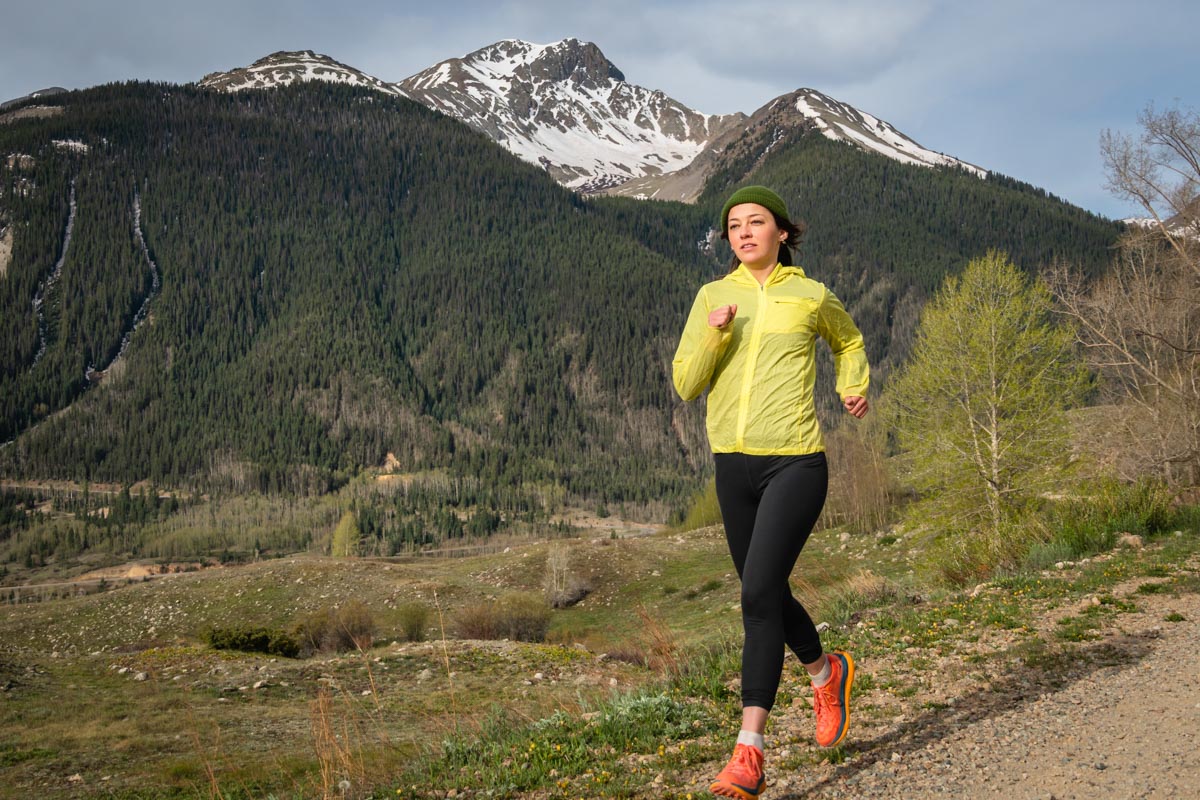
A light shell can help a body retain warmth and be easy to carry if temperatures warm up. Photo: iRunFar/Eszter Horanyi
How do I layer my clothes for running in cold weather?
Layers can be put into three broad categories when thinking about using them for running — base layers, midlayers, and outer shells.
Base layers, like the Smartwool Classic All-Season Merino Base Layer 1/4 Zip, go at the bottom of the pile of the clothing you’re wearing, right next to your skin. They should be breathable and wicking so that they can move moisture away from your skin, allowing it to evaporate instead of staying wet. Most base layers are made of merino wool or some sort of synthetic material and are relatively lightweight.
Midlayers provide insulation during cold weather runs and can be made of a variety of materials. These layers are where you can really dial in comfort. If it’s relatively warm out, a thin wool layer can suffice as a second layer on top of your base layer. Adding a fleece or thicker synthetic layer can add more warmth, and a thin down jacket can also make a great midlayer when it’s really cold out. Our testers love the Patagonia Capilene Air Hoody as a warm midlayer. When running in the cold, you’ll want to make sure that you’re not sweating through your midlayer.
An outer shell, or jacket, is an important layer to protect you from the elements. They can block the wind, keep precipitation from getting your other layers wet, and trap even more air against your body to add extra warmth. A non-breathable outer shell can lead to excess sweating, and you’ll need to be careful with your effort regulation when wearing one. We found the Patagonia Airshed Pro Pullover to be a great hybrid shell option that provided protection from wind, rain, and snow in many different temperatures.
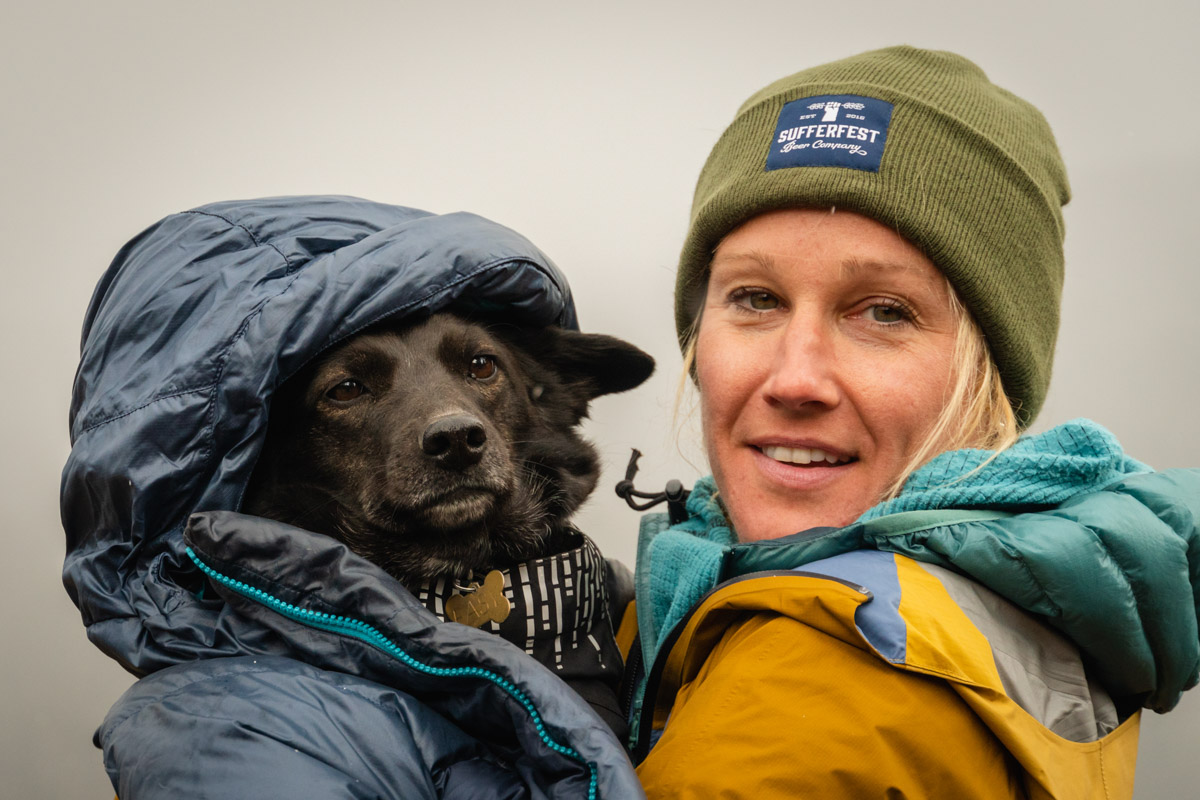
Maggie Guterl and Easy the Doggo showing off layering systems during a spring fastpacking trip. Photo: iRunFar/Eszter Horanyi
Should I wear wool when I run in cold weather?
Wool is a great option for running in cold weather because of its ability to insulate and wick moisture away from your body. The unique fibers grown by merino sheep, mostly in Australia and New Zealand, allow for sweat to evaporate from your body before it turns into actual liquid drops. Unlike cotton or other materials that hold onto liquid, wool can keep you much dryer and help you avoid that clammy feeling associated with other materials. Wool also has a reputation for being able to keep you warm even when wet. While wool shirts and socks are the best-known garments from this material, wool tights, hats, underwear, shorts, and bras, like the Smartwool Merino Sport Seamless Racerback Bra, all make for comfortable and functional pieces of running clothing.
Read more about merino fiber and our top choices for clothing pieces in our Best Wool Running Apparel guide.
How do I choose the best gloves for running in cold weather?
There are endless choices for running gloves, and personal preference plays largely into what will work for you. Hands are often the hardest part of the body to keep warm while running, largely because of lower levels of blood circulation, and the right gloves need to fit properly. Gloves that are too tight can reduce blood circulation even more and make cold hands even colder.
Good gloves for running will wick moisture, provide insulation, and be dexterous enough to let you perform basic tasks with them on. For very cold temperatures, mittens may be the best option. By not separating the fingers into different compartments, they can keep your hands much warmer. Convertible gloves, which can switch between glove and mitten modes, can provide both the dexterity of gloves and the added protection and warmth of mittens. When it came to running on the very coldest of mornings, our testers turned to the Trailheads Convertible Zip Mitts for both their warmth and dexterity.
What are the best socks for running in cold weather?
When it comes to choosing socks for running in cold weather, you need to think about shoe sizing. It may be tempting to throw on a thick pair of socks to try to combat the cold, but this often ends up leading to even colder feet than if you just went with your normal thinner socks. Cold feet are often a result of the lack of circulation as a body starts to reduce blood flow to the extremities in order to keep its vital organs from getting too cold. Putting thick socks on and shoving them into normal-sized running shoes can make the circulation through your feet even worse. If you’re running consistently in temperatures where you want thicker socks, you’ll probably want to buy specific shoes that are a half size or more bigger.
Sock material is also important. As with all cold weather running gear, you want them to be wicking and breathable so that they don’t absorb water and get wet. Many of our testers swear by wool when it comes to socks for running in the cold. They especially liked the Smartwool Run Cold Weather Targeted Cushion Crew Socks. You can read more about the socks the iRunFar team tested in our Best Running Socks guide. We found the Drymax Cold Weather Running Crew to be a great synthetic option for the cold as well.
What hat should I wear to run in cold weather?
A hat is an easy piece of gear to use in your warmth layering system. Even a small, lightweight hat can help your body retain heat when it’s cold out. If you get hot, hats are easy to take off and provide your body with an efficient venting option. At the least, you’ll want a hat to block the wind, wick moisture, and provide a little bit of insulation. Some winter hats, like the Buff Pack Merino Fleece Cap, come with brims to shade your face from the sun. Others have extra material to provide better coverage for your ears. Our Best Running Hats guide covers several hat options, including those designed for cold-weather outings.
Call for Comments
- What do you use to keep warm in the winter?
- Do you live in a climate or have hobbies that necessitate very specific winter gear?
- Use the comments section to share your favorite gear for winter running, too!
